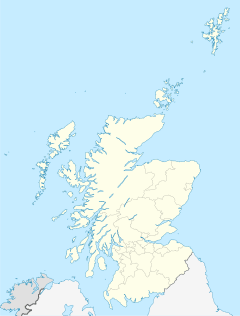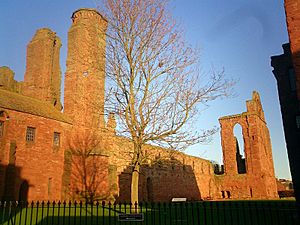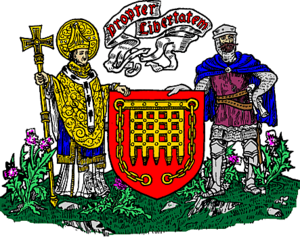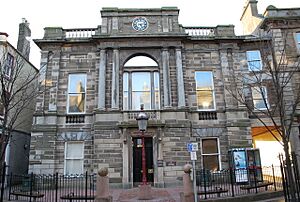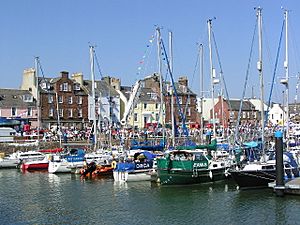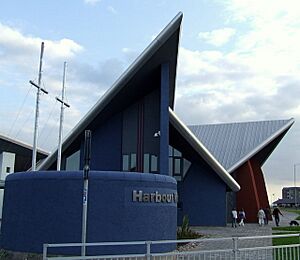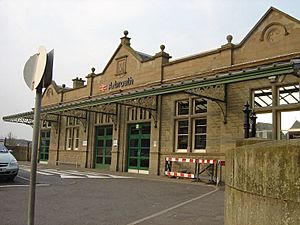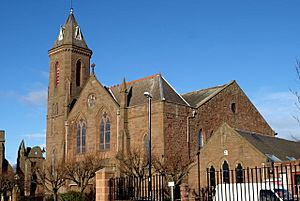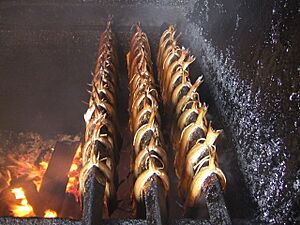Arbroath facts for kids
Quick facts for kids Arbroath
|
|
|---|---|
 Arbroath from the south |
|
| Population | 23,500 (2020) |
| OS grid reference | NO641412 |
| • Edinburgh | 45 mi (72 km) SSW |
| • London | 371 mi (597 km) SSE |
| Council area | |
| Lieutenancy area | |
| Country | Scotland |
| Sovereign state | United Kingdom |
| Post town | ARBROATH |
| Postcode district | DD11 |
| Dialling code | 01241 |
| Ambulance | Scottish |
| EU Parliament | Scotland |
| UK Parliament |
|
| Scottish Parliament |
|
Arbroath (/ɑːrˈbroʊθ/) or Aberbrothock (Scottish Gaelic: Obar Bhrothaig [ˈopəɾ ˈvɾo.ɪkʲ]) is a town on the North Sea coast in Scotland. It is the biggest town in the Angus area. About 23,902 people live there. Arbroath is about 16 miles (26 km) east of Dundee. It is also about 45 miles (72 km) south of Aberdeen.
People lived here in the Iron Age. But the town's story really began in 1178. That's when Arbroath Abbey was built. Arbroath grew a lot during the Industrial Revolution. It became known for making flax and jute products. A new harbour was built in 1839. By the 1900s, Arbroath was a major fishing port in Scotland.
The town is famous for the Declaration of Arbroath. This important document declared Scotland's independence. It is also known for the delicious Arbroath smokie. Arbroath Football Club holds a world record. They scored 36 goals in a professional football match. This was against Bon Accord in 1885.
Contents
- History of Arbroath
- How Arbroath is Governed
- Geography of Arbroath
- Arbroath's Climate
- People of Arbroath
- Arbroath's Economy
- Getting Around Arbroath
- Schools in Arbroath
- Churches in Arbroath
- Culture in Arbroath
- Sports in Arbroath
- Public Services in Arbroath
- Famous People from Arbroath
- Images for kids
- See also
History of Arbroath
What's in a Name?
The town's first name was 'Aberbrothock'. This name came from the Brothock Burn. This stream flows through the town. 'Aber' means a river mouth or where two rivers meet.
The name Aberbrothock was spelled in many ways. Old papers show "Abirbrothoke" or "Aberbrothok". In the famous Declaration of Arbroath, it was "Abirbrothoc".
The name Arbroath became common in the mid-1800s. The older name was mostly forgotten by then.
Ancient Times in Arbroath
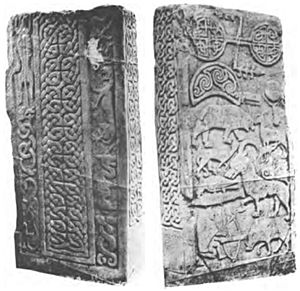
People have lived in the Arbroath area for a very long time. We know this from finds from the Neolithic period. This was around 3500 BCE.
Many Bronze Age items have been found here. These include pottery and gold armlets. Iron Age sites are also found nearby.
The area was important in early Christian times. Pictish stone carvings were found at St Vigeans Church. One stone, the 9th-century Drosten Stone, is special. It has a Latin message. It might refer to a Pictish King named Uurad. He ruled from 839–842 CE.
Medieval Arbroath
Arbroath's recorded history starts in 1178. That's when King William the Lion built Arbroath Abbey. Monks from the Tironensian order lived there. The Abbey was finished in 1233. King William was buried there in 1214.
In the 1200s, King John said Arbroath didn't have to pay taxes. This was true in most of England, except London.
A very important event happened at Arbroath Abbey. On April 6, 1320, the Scottish Parliament met there. They sent a letter to the Pope. This letter is called the Declaration of Arbroath. It was written by Abbot Bernard. The letter proudly stated Scotland's independence. It also praised King Robert the Bruce.
The Battle of Arbroath happened in 1446. It was a fight between two powerful families. About 500 people died. Parts of the town were destroyed.
After the Scottish Reformation, the Abbey was no longer used. Its stones were taken to build houses in the town. In 1815, the ruins became state property. Now, Historic Scotland looks after them.
Modern Arbroath's Growth
The Jacobite rising made Arbroath a Jacobite town. Many local men joined the Jacobite army. Arbroath was also a key port. Supplies and men came from France through here.
The Industrial Revolution helped Arbroath grow. Many new homes were built for workers. The town became known for making jute and sailcloth. By 1867, mills employed 4,620 people. Arbroath even made sails for the famous ship Cutty Sark. The town also made shoes and lawnmowers.
Arbroath is famous for its fishing industry. The harbour was improved in 1839. This brought many fishermen to the town. The industry grew a lot until 1980. Many fishing boats worked from Arbroath. Hundreds of people worked on boats or processed fish. Today, fewer boats work from Arbroath. But fish processing is still a big employer.
How Arbroath is Governed
King William the Lion made Arbroath a special town in 1178. This allowed monks to hold markets and have a harbour. In 1599, King James VI of Scotland made it a royal burgh. This meant it had its own mayor (provost) and town council.
Arbroath was run by its own council until 1975. Then, it became part of a larger area called Tayside. In 1994, Angus (including Arbroath) became its own council area again.
Arbroath has seven councillors on the Angus Council. They represent different parts of the town.
Who Represents Arbroath in Parliament?
Arbroath is part of the Arbroath and Broughty Ferry area. This is for elections to the UK Parliament. Stephen Gethins of the SNP won this seat in 2024.
For the Scottish Parliament, Arbroath is in the Angus South constituency. Graeme Dey of the Scottish National Party has won this seat multiple times.
Geography of Arbroath
Arbroath is on the North Sea coast. It is about 17 miles (27 km) northeast of Dundee. The town is built mostly on Old Red Sandstone.
Arbroath is about 98 miles (158 km) northeast of Glasgow. It is 50 miles (80 km) southwest of Aberdeen. Nearby villages like St Vigeans are often considered part of Arbroath.
The Brothock Water Stream
A stream called Brothock Water flows through Arbroath. It runs from St Vigeans to the North Sea. In the 1800s, many mills were built along the stream. They used its water for their machines.
The stream helps create green spaces in the town. It also divides the town from east to west. New flood protection work was finished in 2022. This helps protect the town from flooding.
Arbroath's Coastline
Southwest of the harbour, there are rocky areas. You can find many rock pools there at low tide. A sandy and pebbly beach stretches for about 900 metres. This is Arbroath West Links beach. It's a popular spot for swimming.
The Arbroath cliffs rise about 1 mile (1.6 km) northeast of the harbour. They show interesting rock layers.
Arbroath's Climate
Arbroath has a typical British weather pattern. It's influenced by being next to the sea. Temperatures don't change much between seasons.
In January, the average high is 6.4°C (43.5°F). In July, it's 18°C (64.4°F). Arbroath is quite dry and sunny for Scotland. It gets about 639.4 mm (25.2 inches) of rain each year. It also gets about 1561.7 hours of sunshine. These numbers are from 1991–2020.
| Climate data for Arbroath 15m asl, 1991–2020 | |||||||||||||
|---|---|---|---|---|---|---|---|---|---|---|---|---|---|
| Month | Jan | Feb | Mar | Apr | May | Jun | Jul | Aug | Sep | Oct | Nov | Dec | Year |
| Record high °C (°F) | 14.5 (58.1) |
15.3 (59.5) |
21.0 (69.8) |
22.6 (72.7) |
24.3 (75.7) |
27.5 (81.5) |
28.4 (83.1) |
28.8 (83.8) |
24.8 (76.6) |
21.4 (70.5) |
15.7 (60.3) |
14.4 (57.9) |
28.8 (83.8) |
| Mean daily maximum °C (°F) | 6.7 (44.1) |
7.2 (45.0) |
8.8 (47.8) |
10.8 (51.4) |
13.4 (56.1) |
16.2 (61.2) |
18.1 (64.6) |
17.8 (64.0) |
15.8 (60.4) |
12.5 (54.5) |
9.3 (48.7) |
7.0 (44.6) |
12.0 (53.6) |
| Mean daily minimum °C (°F) | 1.8 (35.2) |
2.1 (35.8) |
3.0 (37.4) |
4.7 (40.5) |
6.8 (44.2) |
9.6 (49.3) |
11.6 (52.9) |
11.4 (52.5) |
9.7 (49.5) |
7.2 (45.0) |
4.2 (39.6) |
2.2 (36.0) |
6.2 (43.2) |
| Record low °C (°F) | −11.2 (11.8) |
−11.7 (10.9) |
−10.5 (13.1) |
−4.3 (24.3) |
−1.7 (28.9) |
1.2 (34.2) |
4.0 (39.2) |
2.8 (37.0) |
−0.5 (31.1) |
−3.8 (25.2) |
−8.5 (16.7) |
−10.1 (13.8) |
−11.7 (10.9) |
| Average precipitation mm (inches) | 53.9 (2.12) |
45.1 (1.78) |
38.3 (1.51) |
40.5 (1.59) |
51.9 (2.04) |
54.2 (2.13) |
59.7 (2.35) |
65.2 (2.57) |
48.8 (1.92) |
75.7 (2.98) |
57.6 (2.27) |
48.5 (1.91) |
639.4 (25.17) |
| Mean monthly sunshine hours | 59.1 | 87.7 | 130.2 | 171.8 | 204.0 | 183.7 | 183.3 | 173.4 | 138.0 | 102.1 | 75.1 | 53.5 | 1,561.7 |
| Source: Met Office | |||||||||||||
People of Arbroath
People from Arbroath are called Arbroathians. But they often call themselves Red Lichties. This comes from the red lamp that shone from the harbour light. It helped ships find their way into the port.
In 2011, Arbroath had 23,902 residents. Most (86.5%) were born in Scotland. Arbroath has more people under 16 (18.3%) than the rest of Scotland. It also has more people over 65 (18.9%).
Arbroath's Economy
The town's future was once tied to its harbour. The first harbour was built in 1394. A bigger one was made in 1725. Then, it was improved again in 1839. Arbroath became a major port for ships. Goods like timber and groceries came in. Manufactured goods, like sailcloth, were sent out.
Making Things in Arbroath
Arbroath was a centre for making things. In 1795, a local company made oiled flax for sails. This led to waxed cotton in the late 1800s. This industry was big until the 1970s. Many factories closed down after that.
The Royal Marines in Arbroath
Arbroath is home to 45 Commando of the Royal Marines. They have been based at RM Condor since 1971. The barracks were built in 1940. The Royal Marines help the local economy. About 600 local people work for the Ministry of Defence.
Homes in Arbroath
House prices in Arbroath have been growing. In 2006, they were close to the national average. Better roads to Dundee might be making house prices go up. This is because people from Dundee might choose to live in Arbroath.
Tourism in Arbroath
Arbroath is a popular place for visitors in Angus. Arbroath Abbey is the second most visited attraction. About 14,000 people visit the Abbey each year. A play about the Declaration of Arbroath is sometimes performed there. A smaller ceremony happens every year on April 6.
Past Attractions
The Sea Fest was a popular event. It celebrated Arbroath's sea history. It ran for 21 years until 2017. Kerr's Miniature Railway was Scotland's oldest miniature railway. It closed in 2020. The Harbour Visitor Centre used to have a museum. It also had a tourist information office. Both have now closed.
Getting Around Arbroath
The A92 road connects Arbroath to Dundee. It crosses the Tay river on the Tay Road Bridge. North of Arbroath, the A92 goes to Montrose and Aberdeen.
Buses from Arbroath Bus Station go to places like Brechin and Dundee. The X7 Coastrider bus also stops here. It runs between Aberdeen and Perth.
Arbroath railway station is near the bus station. Trains go along the east coast of Scotland. You can go to Aberdeen, Dundee, Edinburgh, and Glasgow. The overnight Caledonian Sleeper train also stops in Arbroath. It goes to London Euston.
The closest airport is Dundee. It has flights to London and Belfast. The bigger international airports are Edinburgh and Aberdeen. There is also a large airfield at the Royal Marines base.
Schools in Arbroath
Dundee and Angus College has a campus in Arbroath. It is in the old Arbroath High School buildings. The town has two secondary schools and seven primary schools. One primary school is Roman Catholic.
High Schools
The two high schools are Arbroath High School and Arbroath Academy. Arbroath High School has about 880 students. It serves west Arbroath and nearby villages. Arbroath Academy opened in 1962. It has about 700 students. It serves east Arbroath and other villages.
College Education
Angus College started in 1957. It merged with Dundee College in 2013. Now it is Dundee and Angus College. The Arbroath campus offers many courses. These are mostly vocational courses. This means they teach skills for specific jobs.
Churches in Arbroath
In 1884, Arbroath had many churches. Today, fewer are still used for worship. Some old church buildings have found new uses.
Church of Scotland
The Old and Abbey Church is in the town centre. It was built in 1797 and made bigger in 1876–8.
St Andrew's is another church. Its minister, Rev. Dr. Martin Fair, was a leader for the whole Church of Scotland in 2020–2021.
The West Kirk opened in 1879. Its tower was made taller in 1903. It joined with other church groups in 1990 and 2019.
Other Churches
There is an Episcopalian church called St Mary the Virgin. It started in 1694. The current building is from 1854.
St Thomas of Canterbury Roman Catholic Church opened in 1848. It has unique twin towers.
St John's Methodist Church is the oldest Methodist church in Scotland still used for worship. It opened in 1772.
Other groups also worship in Arbroath. These include the Salvation Army and Jehovah's Witnesses.
Culture in Arbroath
The ANGUSalive Community Trust manages many places in Arbroath. These include the Library and Art Gallery, Webster Memorial Theatre, Signal Tower Museum, and sports centres.
The Corsar Gallery has two large oil paintings. They are thought to be by Pieter Brueghel the Younger. The art gallery and library are in an old school building. It opened in 1898.
The Webster Memorial Theatre was built in 1867. It was first called 'The Public Hall'. It was renamed in memory of Joseph Webster. He died in World War I. Princess Margaret reopened it in 1970. The theatre can seat 500 people. Many famous performers have been there.
The poet Marion Angus lived in Arbroath. She wrote columns for the Arbroath Guide newspaper. These columns described life in the town.
The Angus Black and White Minstrels used to perform in blackface. In 2005, they stopped using blackface makeup. They changed their name to The Angus Minstrels.
A play about the Declaration of Arbroath is performed at the Abbey ruins. This started in 1947. It tells the story of the signing.
The Arbroath Male Voice Choir started in 1934. They sing many types of songs. They often invite famous singers to perform with them.
The author Sir Walter Scott visited Arbroath. His novel The Antiquary (1816) features fictional versions of Arbroath.
Arbroath has one museum, the Signal Tower Museum. It was once the shore station for the Bell Rock Lighthouse. The museum tells the story of the lighthouse and the town.
Hospitalfield House is a large house near town. It helps promote modern arts.
Arbroath Smokies
Arbroath smokies are famous worldwide. They are made only in Arbroath. This is because they have a special protected status. Smokies are made from haddock. The fish are salted overnight. Then they are hung in a barrel over a hardwood fire. After about an hour, they are golden brown and ready to eat. Making smokies is still a small, traditional business. It is mostly done near the harbour.
Sports in Arbroath
Arbroath F.C. is a semi-professional football team. They are called the Red Lichties. They play at Gayfield Park. This stadium is very close to the North Sea. Arbroath F.C. holds a world record. They won a football match 36–0 in 1885. Arbroath Victoria F.C. is another local football club.
Arbroath Lawn Tennis Club started in 1909. It now has floodlit, all-weather courts. Jonny O'Mara, a famous tennis player, used to be a member.
Arbroath has a rugby union club, Arbroath RFC. It also has several bowls clubs. Darren Burnett, a world champion in bowls, is from Arbroath.
Arbroath has a successful cricket club. They won the Scottish Cup in 2015.
Arbroath is also a good place for fishing.
Public Services in Arbroath
Scottish Water supplies water from nearby reservoirs. Electricity comes from Scottish and Southern Electricity Networks.
Angus Council handles waste. They collect recycling weekly. In 2020, Angus Council recycled 57.9% of its waste. This was the highest rate in Scotland.
Healthcare was developed in the 1800s. Arbroath Infirmary opened in 1845. Today, NHS Tayside provides medical care there. Other health centres offer primary care. The Scottish Ambulance Service serves Arbroath.
Police Scotland has a station in Arbroath. The town is also served by the Scottish Fire and Rescue Service.
A lifeboat station was set up in 1803. It was one of the first in Scotland. The RNLI station has two lifeboats. These are the Robert Ferguson and the Inchcape.
Famous People from Arbroath
- Gus Alexander (1934–2010), footballer
- Marion Angus (1865–1946), poet
- Neil Arnott (1788–1874), doctor and inventor
- David Dunbar Buick (1854–1929), founder of Buick cars
- James Chalmers (1782–1853), Post Office reformer
- Dominik Diamond (born 1969), TV presenter
- Ned Doig (1866–1919), famous goalkeeper
- Martin Fair (born 1964), Church of Scotland leader
- John Ritchie Findlay (1824–1898), newspaper owner
- Graham Gano (born 1987), American football player
- James Glen Sivewright Gibson (1861–1951), architect
- Jamie Gillan (born 1997), American football player
- Robert Pearse Gillies (1789–1858), poet and writer
- George Gordon (1829–1907), civil engineer
- Patrick Hennessy (1915–1980), realist painter
- Harry Lauder (1870–1950), Scottish singer and comedian
- Durward Lely (1852–1944), opera singer
- Bernard of Kilwinning (died c. 1331), Abbot of Arbroath, wrote the Declaration of Arbroath
- David Nicoll Lowe (1909–1999), botanist
- James Mackay, 1st Earl of Inchcape (1852–1932), shipping company chairman
- Gareth Murray (born 1984), basketball player/coach
- Morris Pert (1947–2010), composer and musician
- George Scott Railton (1849–1913), Salvation Army leader
- Alexander Ross (1895–1972), cricketer
- Robert Sievwright (1882–1947), international cricketer
- David Frederick Skea (1871–1950), football player
- Andy Stewart (1933–1993), musician and entertainer
- Gavin Swankie (born 1983), footballer
- Paul Tosh (born 1973), football striker
Images for kids
See also
 In Spanish: Arbroath para niños
In Spanish: Arbroath para niños


